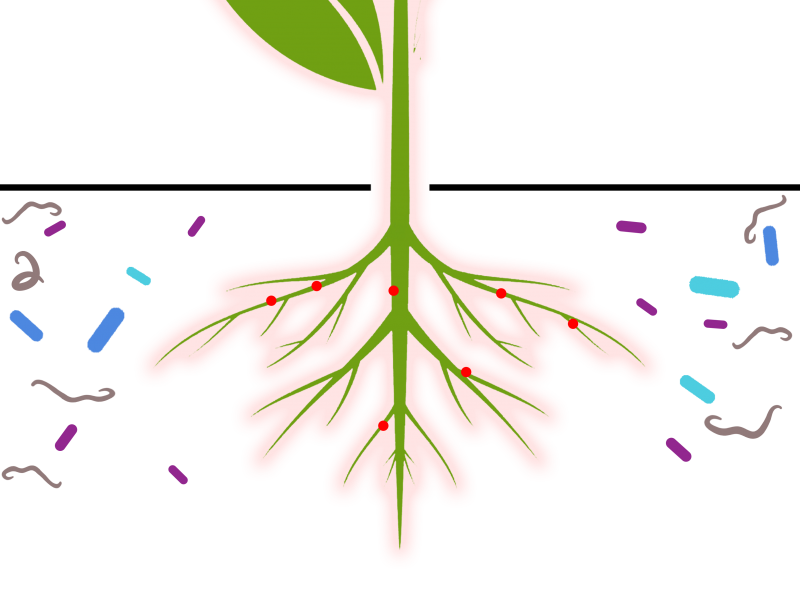Project Overview
Project Description
Introduction
Sustainability is a topic of increasing concern in the field of agriculture, food security and rural development. There is a dire need for innovation in this field; primarily driven by predictions of substantial global population increase coupled with severe pressure on non-renewable resources. The result is a necessity to increase food production whilst reducing our impact on the environment. As such, our aim is to find sustainable solutions that address some of these issues.
Inorganic nitrogen fertiliser production is extremely energy-intensive, accounting for ~1 % of all global energy use.[1] These fertilisers require persistent application as they are rapidly leeched out of the soil shortly after application causing mass pollution worldwide.
The problems with inorganic fertilisers are that they do not last long, they take masses of energy to produce and cause pollution, the most common fertilisers are nitrogen, phosphorus and potassium, the Newcastle iGEM 2018 team aim to provide a source of these nutrients that is sustainable and non-polluting.
Project Description
Introducing Pseudomonas sp.
The organism used by the team is a gram-negative bacterium called Pseudomonas sp. Pseudomonas sp. lives in soil and water, and is capable of colonising roots. Naturally Pseudomonas sp. is known as a plant growth promoter for multiple reasons;
- It produces a siderophore that liberates iron [2], consequentially liberating phosphorus too. [3]
- It has anti-fungal properties (protecting from pathogens). [4]
- It is nematophagous, protecting plants from parasitic nematode worms. [5]
- Produces anti-insectal toxins, protecting from pests. [6]
- It is thought to induce systemic resistance and/or tolerance. [7]
With all these features,Pseudomonas sp. was already an ideal organism for improving crop yields, but the Newcastle iGEM team wanted to take this is a step further.
PROJECT DESCRIPTION
Our Idea
By engineering Pseudomonas sp. to express novel genes, the team aims to manipulate the soil microbial community via chemical attraction/repulsion to achieve desired processes. In our case, this is a nutrient sustaining soil but there are no limits! From soil remediation to pest control, this project aims to create an engineerable chassis out of Pseudomonas sp. so future scientists can manipulate the soil community in any way they like.
Our prototype focuses on sustaining the amount of Nitrogen present in soils without adding fertiliser or causing run-off. To combat this, we have introduced flavonoids to Pseudomonas sp. that attract free-living/non-nodulating nitrogen fixing bacteria to improve the nitrogen content of the soil.
This method means that one application is all that is needed to improve the nutrient availability for a plants life-time. This combined with the other protective roles of Pseudomonas sp. acts to improve crop yields without genetically modifying plants and without nitrogen/phosphorus fertilisers. Even if we only reduce fertiliser use by a tiny amount, globally this would make a huge difference in terms of energy usage and pollution.
Project Description
Our Goals
Sustainability is a topic of increasing concern in the fields of agriculture, food security and rural development. There is a dire need for innovation in this field; primarily driven by predictions of substantial global population increase coupled with severe pressure on non-renewable resources. The result is a necessity to increase food production whilst reducing our impact on the environment. As such, our aim is to find sustainable solutions that address some of these issues.
Inorganic nitrogen fertiliser production is extremely energy-intensive, accounting for ~1 % of all global energy use (Smith 2002 http://science.sciencemag.org/content/297/5587/1654.long ). These fertilisers require persistent application as they are rapidly leeched out of the soil shortly after application causing mass pollution worldwide.
The problems with inorganic fertilisers are that they do not last long, they take masses of energy to produce and cause pollution, the most common fertilisers are Nitrogen, phosphorus and potassium, the Newcastle 2018 team aim to provide a source of these nutrients that is sustainable and non-polluting.
Description
REFERENCES
1. Smith. B (2002). "Nitrogenase Reveals Its Inner Secrets" Science Journal 297: 5587
2. Gómez-Lama Cabanás C, Schilirò E, Valverde-Corredor A, & Mercado-Blanco J (2014) The Biocontrol Endophytic Bacterium Pseudomonas fluorescens PICF7 Induces Systemic Defense Responses in Aerial Tissues Upon Colonization of Olive Roots. Frontiers in Microbiology 5:427.
3. Gross, H. and J. Loper (2009). Genomics of Secondary Metabolite Production by Pseudomonas spp.
4. Sharma SB, Sayyed RZ, Trivedi MH, & Gobi TA (2013) Phosphate Solubilizing Microbes: Sustainable Approach for Managing Phosphorus Deficiency in Agricultural Soils. SpringerPlus 2:587.
5. Ruffner, B., et al. (2013). "Oral Insecticidal Activity of Plant-Associated Pseudomonads." Environmental Microbiology 15(3): 751-763.
6. Jousset, A., et al. (2009). "Predators Promote Defence of Rhizosphere Bacterial Populations by Selective Feeding on Non-Toxic Cheaters." The Isme Journal 3: 666
7. Vanitha SC & Umesha S (2011) Pseudomonas fluorescens mediated systemic resistance in tomato is driven through an elevated synthesis of defense enzymes. Biologia Plantarum 55(2):317-322.








